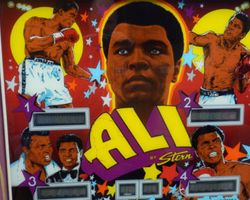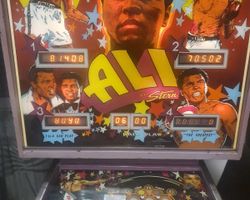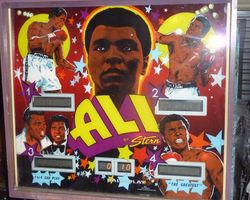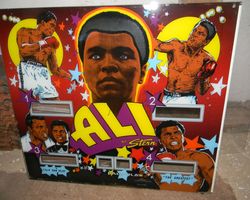
Average Prices: USD $200 to $1,900
Produced: March, 1980
Production Run: 2,971 units
Machine Type: Solid State Electronic
MPU: Stern M-200 MPU
Players: 4
Design by: Harry Williams
Art by: Bob Timm
The pinball machine "Ali," released by Stern Electronics, Inc. in March 1980, captures the essence of boxing through a solid-state electronic platform. This machine was conceived during a pivotal period for Stern, a company making its mark with a series of innovative designs. The decision to base a pinball machine on the persona of Muhammad Ali, a figure globally recognized for his charisma and athletic prowess, provided a compelling theme that resonated with a broad audience. This was a licensed theme, directly connecting the game to one of the most prominent figures of the era.
The design of "Ali" was entrusted to Harry Williams, a designer known for his contributions to the pinball industry. Williams's approach to game layouts often emphasized clear objectives and engaging ball flow, principles evident in "Ali." For the artwork, Bob Timm, working at Ad Posters, provided the visuals for both the backglass and the playfield. Timm's artistic interpretation brought the boxing theme to life, notably utilizing a distinctive purple color scheme that became a signature visual element of the machine. The cabinet art, a separate production process typically handled by cabinet manufacturers, completed the machine's aesthetic. Released to the market with the M-200 MPU system, "Ali" had a production run of 2,971 units, beginning on March 20, 1980, and concluding on May 2, 1980. Of these, 2,950 were full games, and a small batch of 21 units were produced as "knock-down" games, intended for assembly in other regions, specifically exported to Leisure and Allied Industries of Australia. Despite the machine's robust design and engaging theme, Alan McNeil, who programmed the game, noted that "Ali" experienced modest sales during its initial release. An interesting detail is the inclusion of an on/off switch for optional background fight tones, allowing operators to customize the auditory experience.
Signature Features and Design
"Ali" distinguishes itself with several key features that contribute to its gameplay and visual appeal. The machine's design incorporates two sets of 3-bank drop targets, offering players distinct objectives to aim for and rewarding precision shots. A central spinning target adds an element of unpredictability and dynamic scoring potential to the playfield. The game features a prominent horseshoe lane, a challenging shot that requires accuracy to navigate successfully. Four kick-out holes are strategically placed, serving as collection points for specific objectives or as dynamic launchers of the ball back into play. Five standup targets are also integrated, contributing to various scoring opportunities and feature activations.
The artwork by Bob Timm is a defining characteristic, particularly the predominant use of purple. This color choice, while unconventional for a boxing theme, imbues the machine with a unique visual identity, contrasting with the often more aggressive color palettes seen in sports-themed games. The artwork on both the backglass and playfield effectively portrays the energy and persona of Muhammad Ali, using graphical representations of boxing action and thematic elements. These visual and mechanical features work in concert to create an immersive experience, inviting players into the world of boxing with every flip of the ball. The interactive elements, such as the drop targets resetting and the spinner creating high-scoring opportunities, enhance the game's replayability and challenge.
Playfield and Mechanics
The playfield of "Ali" is designed with an open layout, promoting fast-paced gameplay and encouraging continuous ball movement. Major shot opportunities include the aforementioned horseshoe lane, which loops around a section of the playfield, demanding a precise shot for a high reward. Shots aimed at spelling "ALI" are integrated into the playfield, guiding players towards clear objectives. The "uppercut" shot is another notable target, often associated with a bonus collect, tying into the boxing theme. The playfield is equipped with three pop bumpers strategically positioned to create unpredictable deflections and keep the ball in motion, along with two slingshots that provide reactive impulse to the ball, pushing it towards the flippers or into other playfield features.
The design philosophy behind "Ali" emphasizes a blend of speed and clear objectives. The open nature of the playfield minimizes areas where the ball can get stuck or slow down, maintaining a high tempo. This layout encourages players to develop quick reflexes and master control over the ball to navigate its various features. The primary objective, to spell out "Greatest," provides a clear and compelling progression for players. This is achieved by hitting a series of targets and features that incrementally light up letters. The artwork and lighting on the playfield reinforce the boxing arena atmosphere. While the lighting is characteristic of solid-state machines from its era, the aesthetic is enhanced by Timm's art, which utilizes strong lines and a striking color palette to draw players into the game. Every element, from the positioning of the drop targets to the pathways to the kick-out holes, is crafted to contribute to the overall flow and player immersion within the boxing narrative.
Gameplay Dynamics
The gameplay dynamics of "Ali" are characterized by their straightforward yet challenging nature. The primary progression system revolves around spelling the word "Greatest" by hitting specific targets and advancing through various playfield features. Successfully spelling "Greatest" rewards the player with extra balls, a highly sought-after objective that extends gameplay. Another distinct objective is the "Uppercut" bonus collect, which accumulates points and can be cashed in by hitting a designated target, mirroring the powerful punch in boxing. Timed rollovers also contribute to scoring, adding a layer of urgency and precision to certain shots.
The rules are easy to understand, making the game accessible to newcomers while offering sufficient depth to keep experienced players engaged. Players quickly grasp the objective of hitting the drop targets and activating the spinner for high scores. A common strategy involves skillfully navigating the ball through the horseshoe lane, a high-value shot that can significantly boost scores. Players also focus on controlling the ball to consistently hit the targets that spell "Greatest," as extra balls are critical for high scores and prolonged play. The background fight tones, which can be enabled, intensify with the speed of gameplay, adding an auditory layer to the fast-paced action. This combination of clear objectives, challenging shots, and thematic audio creates an engaging experience that is both demanding and rewarding.
Reception and Legacy
The "Ali" pinball machine has garnered a largely positive reception within the pinball community, often being considered an underrated machine and a classic example of its era. Players frequently praise its fast-paced gameplay, robust ball flow, and the variety of shots available across its open playfield. The rules, focused on objectives such as spelling "Greatest" for extra balls and collecting the "Uppercut" bonus, are widely appreciated for their clarity and engaging nature. Many also commend the machine as a fitting tribute to Muhammad Ali, noting how its design and gameplay effectively capture the energy of boxing.
However, feedback on the machine is not entirely uniform. The artwork, while seen as unique and cool by some due to its distinctive purple color scheme and bold style, is also a point of contention for others who find it dated or somewhat repetitive. The sound effects, typical for solid-state machines of the early 1980s, are generally considered average, with some players finding them repetitive. The game's difficulty is another aspect that receives mixed reactions; while some appreciate the challenge of mastering the shots, particularly the upper kick-out shots, others find it excessively difficult. Despite these criticisms, the overall sentiment remains strong. "Ali" holds a respectable place in pinball history, particularly within Stern Electronics' early solid-state catalog. Its design principles, emphasizing speed and clear objectives, subtly influenced subsequent machine designs. It is often celebrated for its raw, engaging gameplay and its bold thematic presentation, solidifying its reputation as a fun and challenging machine that continues to appeal to enthusiasts.
Sponsored Links
 Ebay Listings
Ebay Listings
 Auction Results
Auction Results
| Cost | Location | Date |
|---|---|---|
| USD $500 |  Nevada, United States Nevada, United States |
02 March, 2025 |
| USD $3,400 |  Texas, United States Texas, United States |
19 April, 2024 |
| USD $4,000 |  New Jersey, United States New Jersey, United States |
30 December, 2023 |
| EUR €1,898 |  Hessen, Germany Hessen, Germany |
13 December, 2022 |
| EUR €2,600 |  Hessen, Germany Hessen, Germany |
08 December, 2022 |
| EUR €1,590 |  Hessen, Germany Hessen, Germany |
06 December, 2022 |
| USD $3,999 |  Florida, United States Florida, United States |
15 March, 2020 |
| EUR €4,000 |  Brandenburg, Germany Brandenburg, Germany |
21 February, 2020 |
| AUD $1,980 |  New South Wales, Australia New South Wales, Australia |
30 November, 2019 |
| AUD $2,090 |  New South Wales, Australia New South Wales, Australia |
11 November, 2019 |


Private Policy · Search Website · Contact Us
As an eBay Partner, we may earn a commission from qualifying purchases made through links on this site, at no additional cost to you.
All trademarks and copyrighted materials remain property of their respective owners. All other content copyright 2007 - 2025 Pinpedia.







